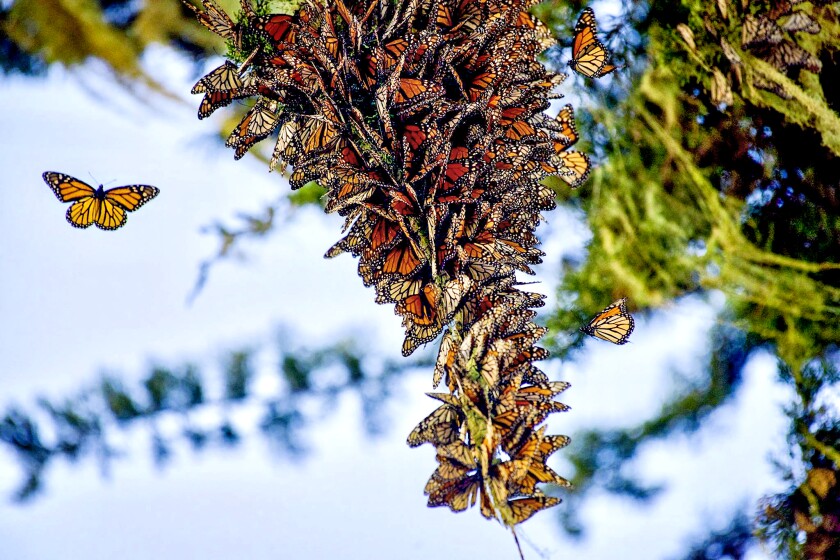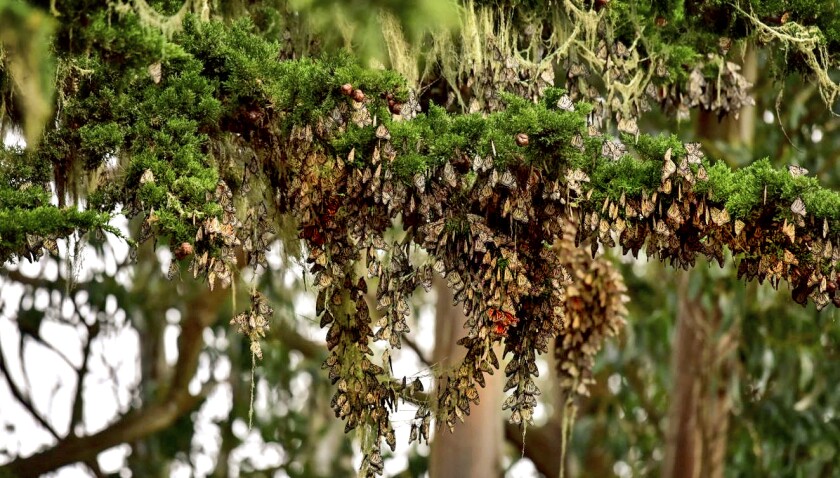This is not a drill. California is poised to lose the Western monarch butterfly and its mysterious annual migration from the continent’s Western regions to the coastal areas between Baja to Mendocino.
The list for blame is long — habitat destruction, insecticides, herbicides and yes, good intentions, because if you’ve ever planted a showy orange milkweed in Southern California with the goal of helping the monarch, consider yourself part of the problem.
So why should we care? First off, caterpillars are a critical food source for most songbirds, which rely heavily on insects, especially caterpillars and spiders, to feed their young. Second, butterflies, like bees, are important pollinators. Adult monarchs sip nectar from many blossoms. and as they flit among flowers, they are also spreading pollen, helping the plants produce seeds, which also feeds birds and other wildlife, and, of course, helps the plant reproduce.
And third, butterflies are just plain beautiful, especially the monarch with its orange wings ribbed in black and white dots on the edges. Can our world really afford to lose something so miraculous?
Fortunately, there are things SoCal gardeners and plant parents can do to help monarchs survive, such as eliminating any use of pesticides or herbicides on their property — but first a little background:
Eastern monarch butterflies are well known for their famous migration from the Eastern and and Central regions of the United States to Mexico each winter, where they congregate by the thousands to mate and stay warm. Their numbers have dropped significantly, from 384 million in 1996 to 60 million in 2019.
But their cousins, the Western monarchs, have seen a more terrible decline.
Western monarch numbers have been steadily dropping for decades, from 1.2 million in 1997 to 30,000 in 2019, but the most recent results from the 24th Western Monarch Thanksgiving Count are staggering — just 1,914 butterflies total, down from the millions who used to migrate from the Pacific Northwest and Central California to overwinter along the coast from Mendocino in Northern California to Ensenada in Baja California.
One of the most disturbing finds from last fall came after wildfire ripped through the area around Pacific Grove, a.k.a. Butterfly Town, USA, in the midst of traditional migration season. During the annual Thanksgiving count, not a single monarch was found in Pacific Grove, a tourist mecca for people who come to marvel at the swarms of Western monarchs that congregate during the winter, clinging to eucalyptus and pine branches to find protection from the cold and wind.

Western monarch butterflies clustering at Pacific Grove Monarch Butterfly Sanctuary in 2016, when 17,100 monarchs were counted at the sanctuary.
(Connie Masotti)
Monarch numbers have been dwindling for decades in Pacific Grove, said Caleb Schneider, the city’s environmental programs manager and manager of the Pacific Grove Monarch Butterfly Sanctuary, and he believes the ill-timed fires contributed to last year’s decline.
“In 1997 there were 45,000 butterflies at our sanctuary and now there’s zero,” Schneider said. “I’ve been here six years, and I never got a chance to see what butterfly clustering in Pacific Grove really looked like; where historically the branches were getting ripped off the trees because there were so many butterflies. I’m watching the extinction of a natural phenomenon.”
The U.S Fish and Wildlife Service announced in December that while the monarch butterfly meets the criteria to be listed as an endangered species, they aren’t being added to the list because the agency must first complete plans to save 161 other endangered species. Basically, the agency is required to address those other species first, and it doesn’t have resources to do more.
The agency will review the monarch’s status each year “until it is no longer a candidate,” the announcement said. “Our conservation goal is to improve monarch populations, and we encourage everyone to join the effort.”
Bottom line: Right now, folks, it’s up to us.

Western monarch butterflies clustering on a pine bough at Pacific Grove Monarch Butterfly Sanctuary in 2016.
(Connie Masotti)
Good news: There are things we can do as individuals, from creating habitats in our yards and windowsills to lobbying our leaders.
Frustrating news: You may need to rip out the milkweed plants you thought were helping in the first place.
Here’s why:
Monarch caterpillars eat only one plant: milkweed, and many Californians have planted the showy tropical milkweed (Asclepias curassavica) to help. Indeed, most SoCal nurseries only offer tropical milkweed, a handsome non-native plant with feathery purplish-green leaves and deep orange flowers.
But well-meaning gardeners who plant this kind of milkweed are actually harming, not helping.
The problem is that tropical milkweed doesn’t die back during the winter in temperate climates like Southern California’s, according to the Xerces Society for Invertebrate Conservation. That permits protozoa parasites (Ophryocystis elektroscirrha, or OE) to multiply on the plants, which are eaten by the caterpillars when they hatch.
When the caterpillars consume too many OE parasites, scientists believe it sickens and weakens adult monarchs, messing up their migration patterns, mating success, flight ability and lifespan. And having milkweed that blooms through the winter also disrupts the butterfly’s migration patterns, experts say.
In other words, those evergreen tropical milkweed do more harm than good in Southern California, says Ron Vanderhoff, general manager of Roger’s Gardens nursery in Corona del Mar. That’s why the nursery stopped selling tropical milkweed a couple years ago.
Moreover, the nursery has started a milkweed exchange program. When native milkweeds are available in the spring, Roger’s Gardens will provide a free native milkweed plant to customers who bring in a tropical milkweed that they’ve pulled from their yard (only one free plant per person).
Vanderhoff said he understands how hard it is to pull out established plants that seem to be helping butterflies. “Monarchs are a very emotional topic with many people, and there is a large and vocal audience of folks who think they are doing the right thing,” he wrote in an email to the Los Angeles Times. “It’s a lot like feeding ducks a bag of breadcrumbs every Tuesday at the local park. The ducks love it and it ‘feels’ like you are really doing a loving and wonderful thing but you are not. You are harming the ducks.”
If you can’t bear to pull out your tropical milkweed, at a minimum cut it down to the ground around Thanksgiving and keep it trimmed low until April to kill any overwintering parasites, said Travis Longcore, urban ecologist and science director for the Urban Wildlands Group.
And don’t despair. Here are six things individuals can do to help monarchs survive and thrive. For more information check out the Xerces Society’s guide, “Western Monarchs Are in Trouble. This Is How You Can Help.”
1. Grow native milkweed
Check with garden centers, especially native plant nurseries, to see when their native milkweed goes on sale — generally in April. Check the Monarch Milkweed Mapper and try to plant varieties native to your area. You don’t need a yard to do this. You can do this in pots on a balcony, window sill or front porch. The most prominent native varieties sold in Southern California include narrow-leaf milkweed (Asclepias fascicularis), with clusters of tiny pink flowers, California milkweed (Asclepias californica), with purplish flower clusters, and woollypod milkweed (Asclepias eriocarpa), with hairy pinkish or ivory buds. You can also try purchasing seed and sowing in a prepared garden bed or container in late winter or very early spring, especially before a rain, since milkweed germinates poorly when it’s hot. Sowing tip: Mix these small seeds with sand to make them easier to disperse.
2. Make sure it’s organic
Anyone who’s grown milkweed knows the plants are a magnet for bright orange aphids, so much so that some wholesale growers use systemic pesticides to produce lovely bug-free plants, said Vanderhoff, general manager at Roger’s Gardens nursery. The problem is that homeowners take their plants home, unaware that they’re laced with pesticides that will be toxic to any caterpillars that try to eat them. “There is no way to look at a plant in a nursery and tell if it’s been treated or not,” he said, so seek out organically grown plants. (P.S. The aphids may look unsightly, but they won’t really hurt the plant or the caterpillars, experts say. If they bother you, try washing them off with a strong stream of water or — deep breath — smooshing them with gloved fingers.)
3. Lobby your garden center
If enough people start asking for native milkweed and stop buying the tropical variety, nurseries will respond. Just remember you can’t buy native milkweed in the winter because it’s dormant, so ask for seed too.
4. Plant lots of nectar flowers
Unlike the one-plant caterpillar, adult monarchs happily sip the nectar from many flowers. The Xerces Society has created a list of monarch nectar plants for Southern California that includes drought-tolerant natives attractive to many butterflies, such as black sage, bluedicks, sunflowers, seaside fleabane and the dainty fairy-cap flowers of manzanita. Another good choice: native buckwheats, whose flowers support a number of pollinators. And again, you don’t need a yard to do this. A window box of lovely blooms can do the trick.
5. Don’t try to “rescue” monarchs
Scientists are still trying to understand how monarchs know when and where to migrate each year, but they have found that butterflies raised indoors seem to lose their innate navigation system and can’t migrate properly, said Urban Wildlands’ Longcore. So if you do try to raise monarchs, make sure the enclosure is outdoors. The same applies to moving monarchs from one location to another in the hopes of helping their survival, Schneider said. “We’ve had people literally pick up monarchs in the Bay Area and drive them down to our sanctuary [in Pacific Grove] to release them, but by manually migrating them you might be doing more harm than good,” he said, by introducing diseases to the wild population and further disorienting the butterflies.
6. Don’t use pesticides or herbicides
Milkweed used to grow wild in agricultural areas or alongside roads, but the use of herbicides to kill weeds has destroyed much of the monarch’s food source, said Longcore. The advent of genetically modified crops that can withstand herbicides has made it easier for farmers to get rid of weeds, but it’s also wiped out beneficial “weeds” that support pollinators such as butterflies and bees. Longcore said insecticides such as neonicotinoids — designed to kill sap-sucking insects such as aphids — appear harmful to butterflies and other pollinators, since the toxic residue accumulates in the pollen and nectar of treated plants. The best action here, he said, is to avoid using these chemicals in our yards and to lobby our representatives and government agencies to phase out their use because they are devastating the beneficial insects who pollinate our food.
“We’re poisoning our insects away, but the system doesn’t work without them,” Schneider said. “Unless you want to teach hundreds of thousands of kindergarteners to go around with paintbrushes and sample pollen from one flower to another, it’s not going to work.”
from Lifestyle https://ift.tt/2NWzGcA
via IFTTT

comment 0 Comment
more_vert